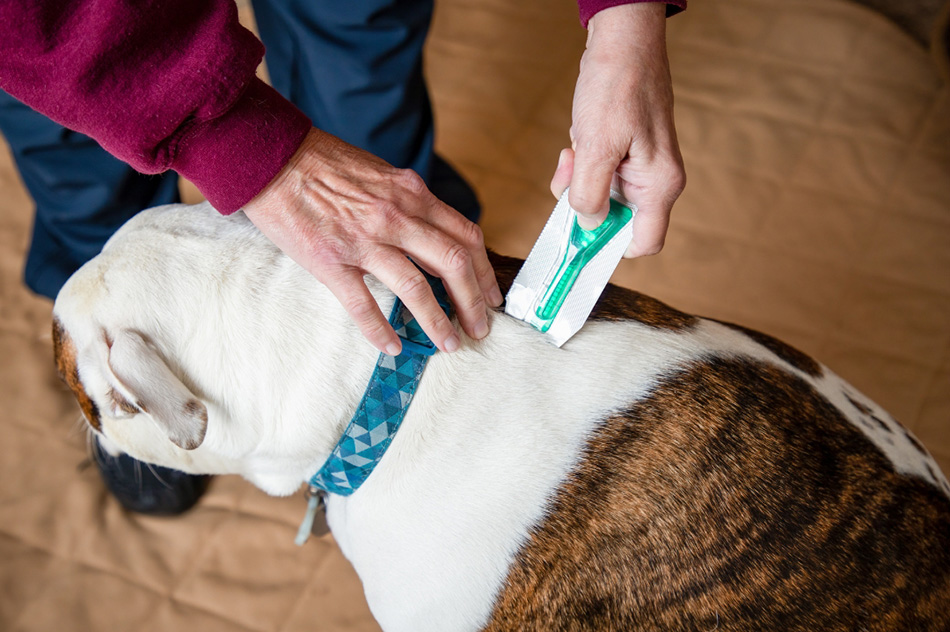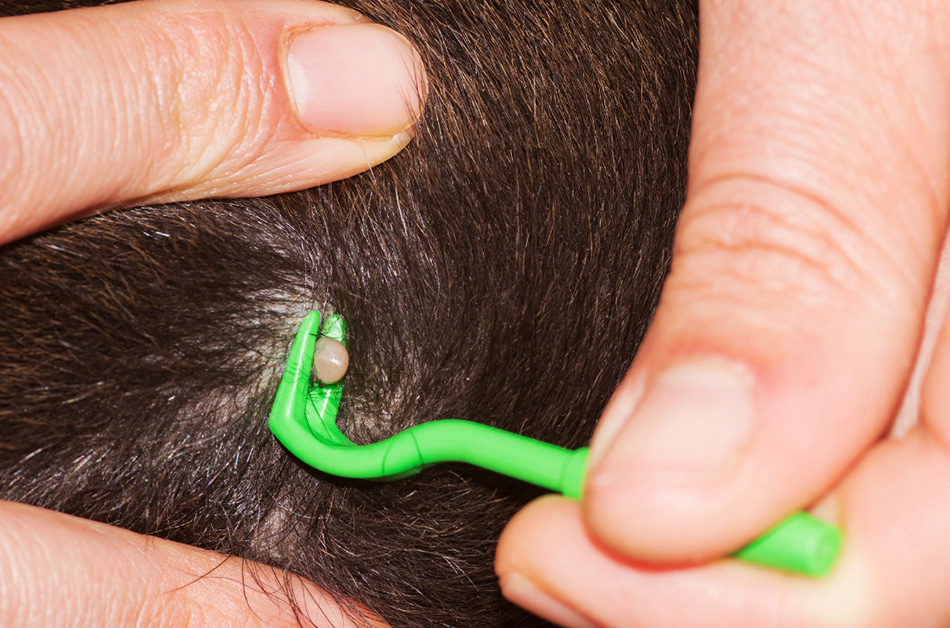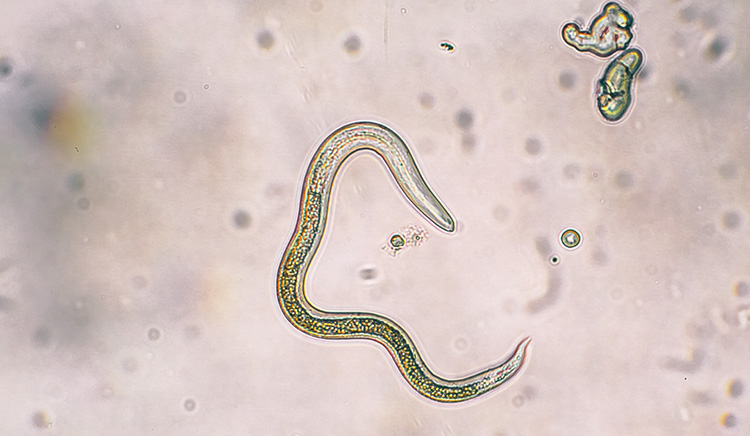Parasite definition: Parasites are creatures that live inside or on another organism, known as the host, and feed on it and at the same time produce harm.

Preventative treatments are best
Often, you’ll hear it called ‘flea treatment’ but actually that little pipette or tablet of medicine will protect your pet against a whole host of bugs.
The brands that you get from your vets are the best choice – they will offer the most complete protection and up-to-date ‘recipes’ for the current parasites in the UK.
Follow the instructions – some will be topical (put on the skin) and some will be edible (in their food). If you have a pet that is difficult to put treatment on topically, then there are options for edible tablets or liquids. You’ll need to repeat them at a regular basis so mark it on your calendar, so you don’t forget!
WARNING Don’t use cat medicine for dogs, or vice versa. They are for different parasites and can cause harm.
To protect the environment, don’t let dogs swim, give them a bath, or go to the groomers for a few days after the treatment. And make sure to dispose of the packaging properly in household waste. Use of these treatments can be tailored to suit your pet – speak to your vet.
VIDEO » Watch our video on how to give parasite treatment to cats
VIDEO » Watch our video on how to give parasite treatment to dogs
A closer look at our most common pet parasites

Flea seen under a microscope
Flea
Ctenocephalides canis (dog) or felis (cat)
Where from? Our most common parasite, they live on wild and livestock animals, grass, trees and shrubs.
Symptoms. They are very itchy, your pet will be scratching and chewing which can leave sores. We often see pets with an allergy to fleas, which can lead to dermatitis and their fur falling out which is even more itchy. Worse-case scenario is when kittens have a flea infestation, they can become anaemic and die.
Fleas are super tiny so are difficult to see unless they move against pale fur. You’ll more likely see black speckles of ‘flea dirt’ – a delightful mix of flea poop and blood.
Oh, and you’ll be having bites around your ankles too… although they can’t live on you, they’ll give you a good nibble.

Cat with sparse fur and sores from scratching are a sign of a flea allergy and infestation that has gone untreated
Treatment. Prevention is WAY better than cure as they spread so quickly, and you’ll soon be having to treat your whole carpet and bedding for eggs and larvae once you have them.
We do not recommend flea collars which can cause skin irritation, sometimes stomach problems and even nervous system issues.
TOP TIP Keep up with your meds even in winter – fleas love your heated house!
STORY » To find out about the lengthy, intensive and expensive treatment once a pet is infested, read Mole’s story.

Ticks are an arachnid, this one here has not fed recently and will be wating for a mammal to brush past
Tick
Ixodes ricinus (this is the most common species, there are some other species in the UK as well)
Where from? Find them in long grass, meadows, parks, woodlands, especially when warm, wet weather is upon us. Ticks can sense a potential host is nearby using an organ on their foreleg that detects heat and chemicals (they are pretty amazing except that they are parasites!) and will climb tall blades to be ready to attach on.
Symptoms. You won’t see your pet reacting to it, as the tick releases a pain-relief chemical when it bites to stop being swatted off, so if you feel a lump when brushing or fussing your pet and your pet doesn’t react to you touching it, take a closer look – it may well be a tick. They often attach where skin is thin, so around the ears and under leg pits. They look a bit like an apple-seed but range 1mm to 1cm size, with their body ballooning as they feed.

A tick with its head buried into the skin
Ticks can carry diseases which are transmitted as they feed, and they circulate saliva with the blood. The one we are most concerned about is Lyme Disease, which can also affect humans. However, the risk is low – only about 4% of ticks carry Lyme Disease and it takes a couple of days of feeding before there is any transmission.
Lyme Disease symptoms in pets include fever, loss of appetite, intermittent lameness and lethargy. In humans it is a rash, fever, headache, tiredness and joint or muscle pain.
The most common problems are because ticks were not removed properly and mouth parts are left under the skin, which becomes infected.
Treatment. Your preventative parasite treatment will help stop the tick staying on too long.
If your pet has one, remove with a tick remover or ask at a vets if you are not confident. Follow by cleaning the area with a pet-suitable antiseptic or soapy wash. Once the tick is off your pet, kill it by submerging in surgical spirit or soapy water in a small container. Clean pet bedding to remove any potential nymphs or larva.

Tick being removed, you can see it is bloated with blood
MYTH BUSTING! There are lots of false treatments that the internet suggests – but do not smother them, burn or freeze them. This could leave mouth parts inside your pet’s skin and that will get infected.
CITIZEN SCIENCE You can get involved with monitoring tick populations in the UK by sending in any ticks you find on your pet to the Tick Surveillance Scheme, part of the National Biodiversity Network. » Visit their website for the form and details on how to send them in.

Roundworm seen under a microscope
Roundworm
Toxocara canis (dog) or cati (cat)
Where from? From infected soil, eating faeces, eating infected wild animals – eggs can survive in the environment for many months. Puppies and kittens can get it from their mother’s milk if she is infected. It is very common.
Symptoms. Often you won’t see anything, so vet advice is to treat regularly assuming they are there. If they do have an infestation, they might be scooting (rubbing their bum across the floor) as it causes diarrhoea and itchiness, and you may see some types of worms like grains of rice or spaghetti in their poop or vomit.
We often get kittens and puppies come into the rehoming centre with big pot-bellies – but they are full of worms, not food. Puppies and kittens need worming much more regularly than adults. It can be serious for young and old pets as it causes sickness and diarrhoea, and can be very serious to people, causing organ damage and blindness.

A kitten with a pot belly is an indication they have worms. Kittens and puppies need worming much more regularly than adults
Treatment. Give regular treatment - the vet-prescribed regular medicine is separate to the flea and parasite treatments. It shouldn’t give an upset stomach but do follow the instructions which may tell you to wait a short while before feeding a main meal. Play more with your cat so they have less need to hunt animals outside.

Wash any toys that have been left outside in the garden
Lungworm
Angiostrongylus vasorum (dogs) or abstrusus (cats)
Where from? From infected slugs, snails and frogs, so most at risk are pets that eat these animals, or lick grass/toys/bowls that has had slugs and snails on. The larvae grows in the blood vessels that supply the heart and lungs. It is becoming more common in the UK in recent years for dogs but is still quite rare for cats.
Symptoms. Coughing, wheezing, reluctant to exercise, nose bleeds. If they have lungworm then they can be treated and survive if caught early, but they could die if left untreated. The dog parasite is more dangerous.
Treatment. Preventative is best. Vet-prescribed parasite treatment will include lungworm protection alongside the more common flea and mites. Wash any toys that have been left out in the garden, and play more with your cat so they have less need to hunt animals outside.
» DOWNLOAD this as a printable page